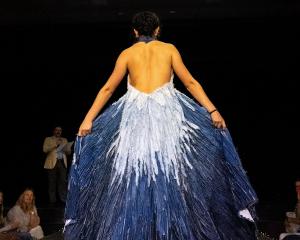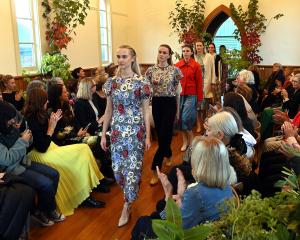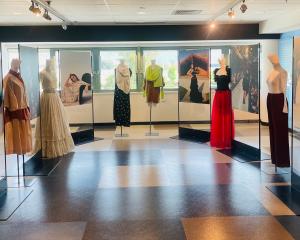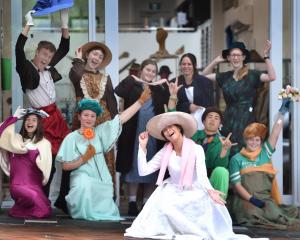Upcycled fashion is a strong rejection of mass-produced, throwaway clothing manufacture. Jude Hathaway checks in on a tenacious young Dunedin designer who is following the concept to shape a career.
When Dunedin designer Melanie Child began studying at the Otago Polytechnic School of Design (fashion) she struggled to find her niche.
''I felt that it was important to know who I was as a designer and I didn't, so some subjects were quite difficult. For instance, while learning the fundamentals of construction and pattern-making I was uninspired by the flat lengths of fabric and pattern paper.''
However, she was encouraged by a lecturer who assured her that this was one of the reasons she was studying and to be patient.
How right!
Halfway through her second year she came upon the brilliant Antwerp designer Martin Margiela's Artisanal line. Artisanal is about gathering up bits and pieces from other times and places to repurpose in the here and now.
''This was my first glimpse into upcycling, which is all about transforming existing clothes into more beautiful garments It was like an epiphany and I knew this was what I wanted to do.''
And she did it well enough in her final year (2009) to be selected as a finalist in the iD International Emerging Designer Awards and graduate with distinction. Child had come to Dunedin to study from Christchurch.
''There was a strong pull to Dunedin as my parents and grandmother lived here for many years and I was familiar with the city.''
Since graduating and taking time out to tend to her now 18-month-old daughter Ajyah, she has worked hard, being rewarded by taking away the top Wairarapa Environmental Award of Excellence at the Oversew Fashion Awards in Carterton last month.
She also won the Paulownia Estate Professional Palette Award with the same garment, a stylish, eye-catching dress she titled ''From Dawn to Dusk''.
Her design ingenuity is clear in the dress, created from a pair of men's wool trousers and featuring a swathe of shirt collars rippling down one side of the bodice and skirt as flaps.
''I was thrilled when told that this was a garment that epitomised what organisers were wishing to achieve with the awards,'' she said.
When Child began designing in a commercial capacity she learned quickly there was a right way of sourcing clothes to get consistency within her specific designs.
''It was a learning curve for me to realise how many similar second-hand garments, such as men's white shirts, were required to be enough to re-create more than one in a line,'' she explained.
''I have to shop around carefully to find similar enough garments to produce three or four of my designs. I soon learned how many tones of black or white there are and the varying details within the same type of garment because they are mass manufactured in different factories.''
The variety results in subtle differences between her garments, which customers enjoy.
''This way each piece retains exclusivity for its owner,'' Child pointed out.
Her first collection, ''Holism'', in 2012, was made possible by an enterprise allowance grant through the Ministry of Social Development.
This was the springboard to her design career.
Next came ''Metamorphose'' last summer, which she has extended into the 2014 winter.
The designer is dedicated to the upcycling ethos.
''I have a compelling fascination and aversion to mass production and its byproducts.''
Her design aesthetic is ''21st-century grunge meets high end streetwear''.
There are nuances of earlier Nom*D ranges, which was a pioneer of the concept of ''new-from-old'', with startling results.
But her tenacious originality makes it clear she walks her own path.
Child predominantly uses second-hand and discarded garments to work her magic rather than discarded fabrics.
''I am passionate about the original garments and their existing shapes and textures, which often give me inspiration.''
She sources them from landfill shops and op shops, including Shop on Carroll, where she volunteered while studying in return for clothes she could upcycle.
The business also sponsored her in her final year of design studies and continues to help her source garments.
''My focus is always on quality garments in pure wool, cotton, denim and T-shirts, but I tend to go for garments that are really outdated as there are always so much more of them. And I prefer menswear because of the amount of fabric in each garment,'' she said with a smile.
In her studio working drawings give a clue to her love of art.
She initially wanted to go to art school but sewing classes at Burnside High School cemented a desire to study fashion.
''I realised that fashion was a more practical application for my creativity.''
Child uses intricate seam detailing to sculpt her shapes and the final silhouette.
Her approach to design uses the draping technique, pinning and creating seams on the dressmaker's form.
This results in garments that skim the figure in the right places; they're feminine and detailed.
Since she has returned to regular part-time designing she is not producing full seasonal ranges at once but rather releasing three or four garments at a time, making regular drops throughout the season.
''I find that this creates anticipation for the stock but it also sits better with my ethos, which is about promoting slow fashion and quality pieces that the wearer will keep in their wardrobe for years."
She stocks Salisbury Boutique in Dunedin and has items available online.
Child also incorporates made-to-measure work into her day-to-day schedule.
''Unlike some designers I do not have a problem with this as I want to encourage clients to come and have something special made for them so that they do not have to always buy off the peg.
"Many people are intrigued by upcycling and want something made for them specifically. It is always a collaborative process between myself and the client.''
Her long-time goal is to be completely self-employed, to support herself and her family, open a concept store and be stocked nationally and internationally.
''I'd love to have a hand-picked team and maybe someone to partner with who could look after the business side.''
And she is proud that in today's fashion world of mass production and throwaway mentality she is building a brand on sustainability and that while it applauds eco-fashion, it is quite edgy, dark and moody, which is not often found in eco labels.
Yes, Melanie Child has found her niche.












